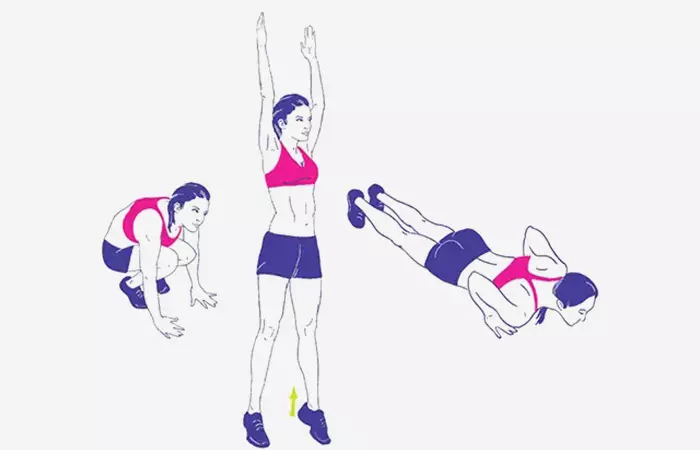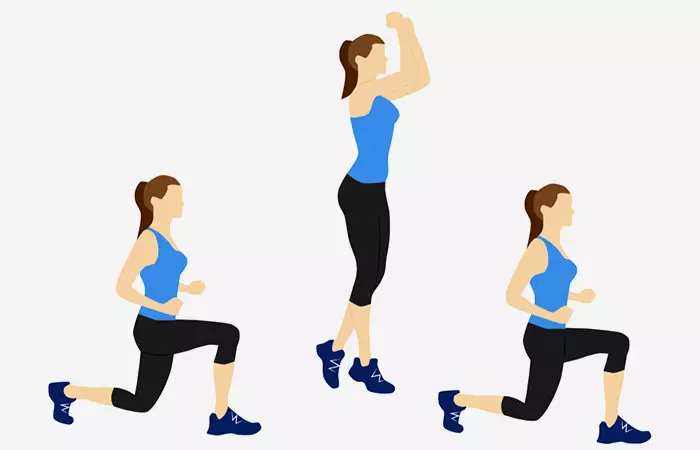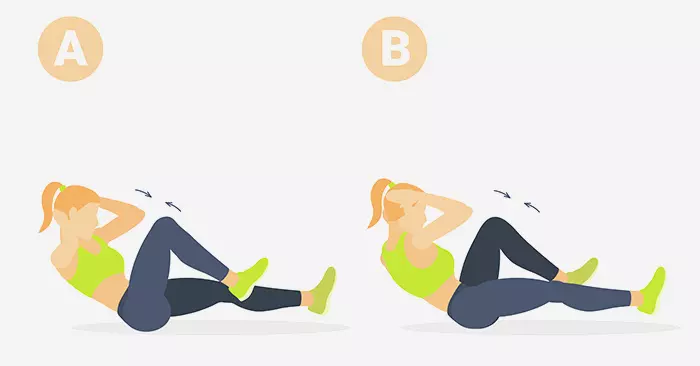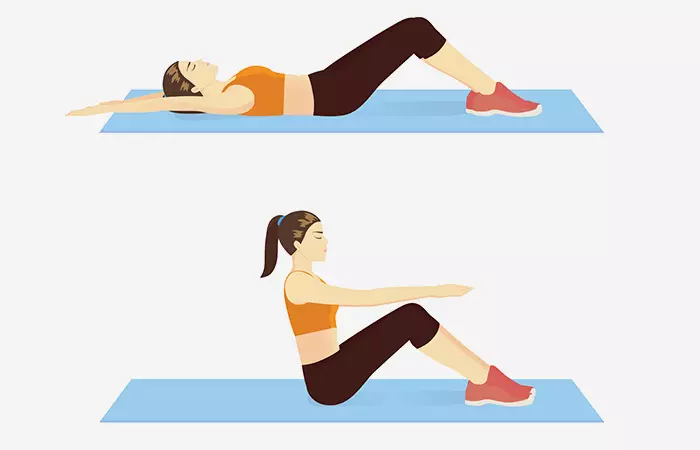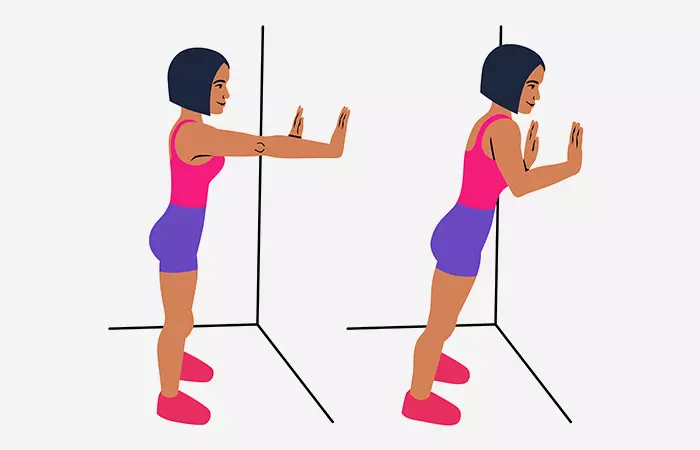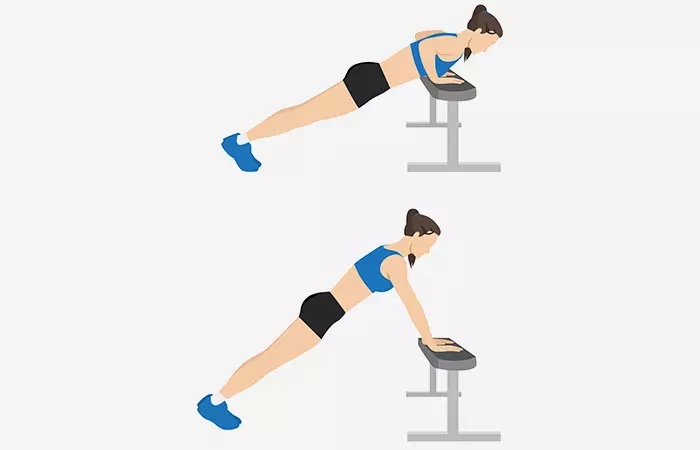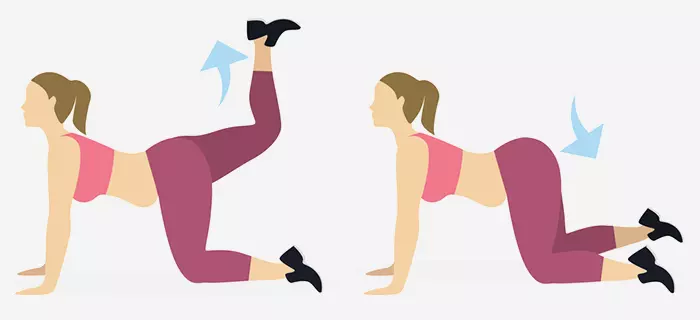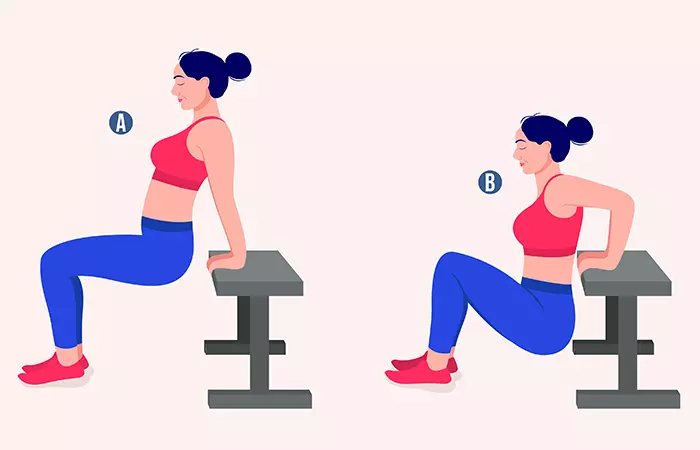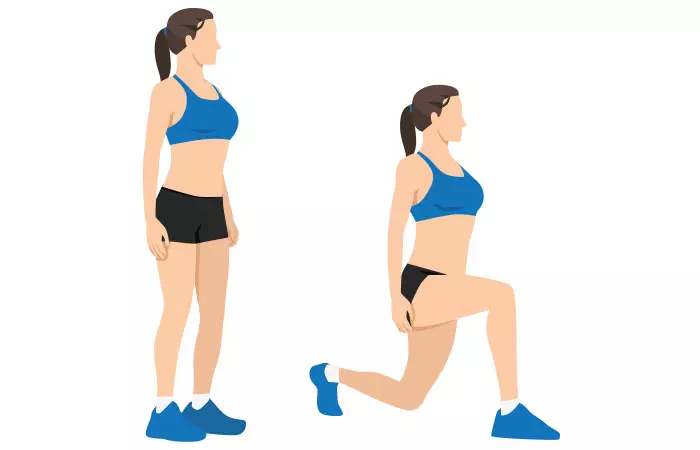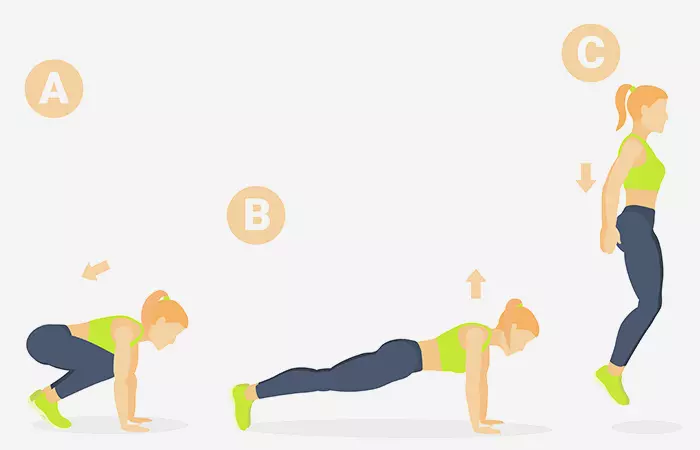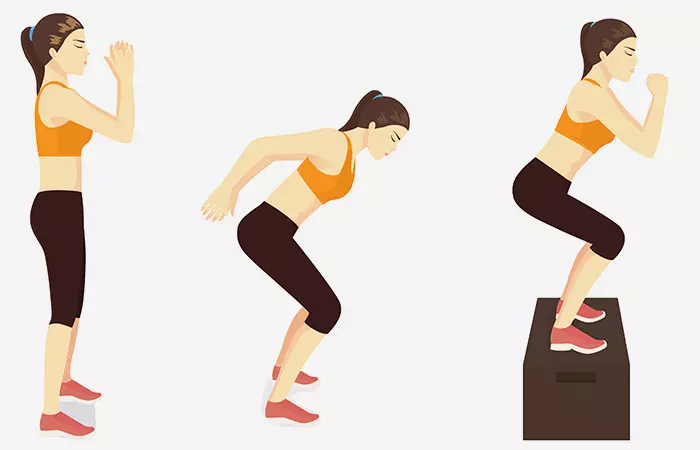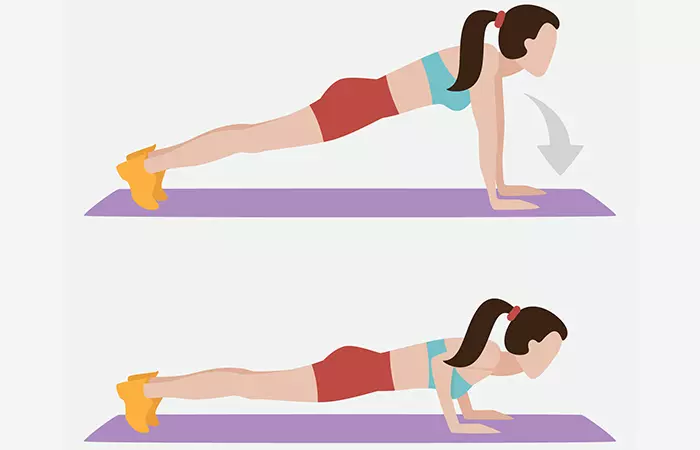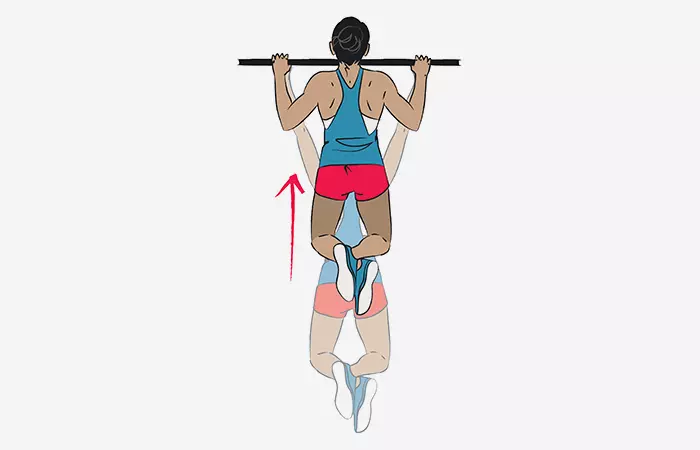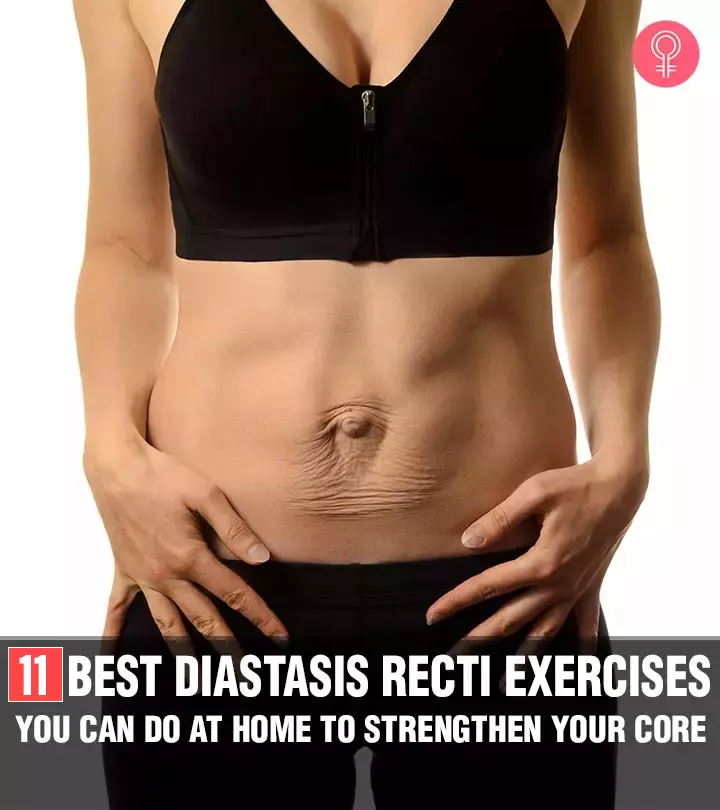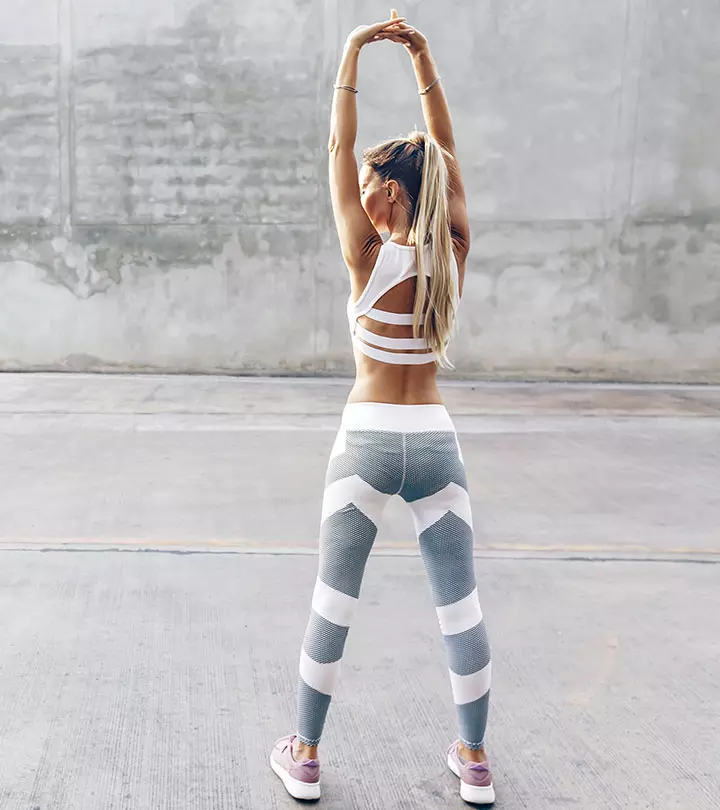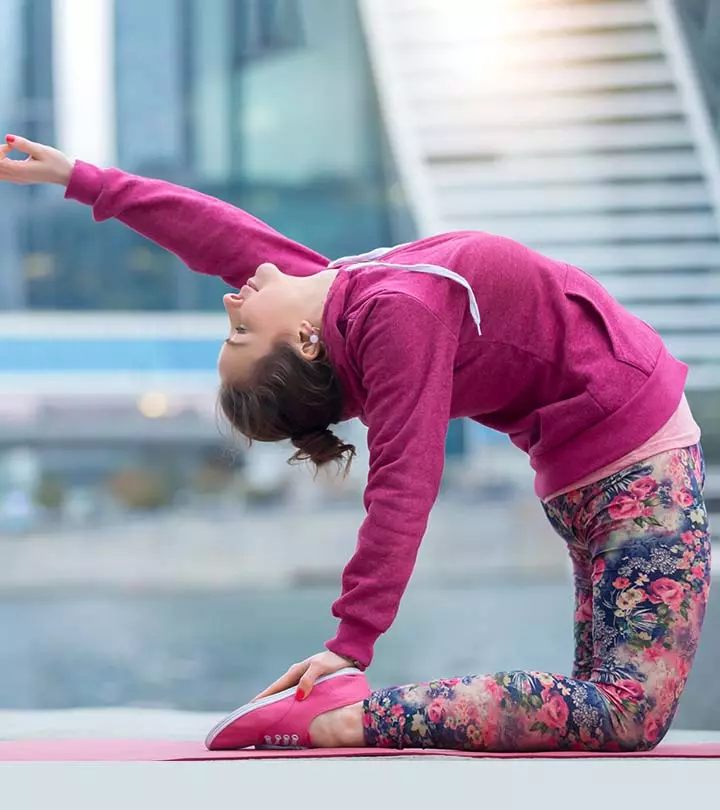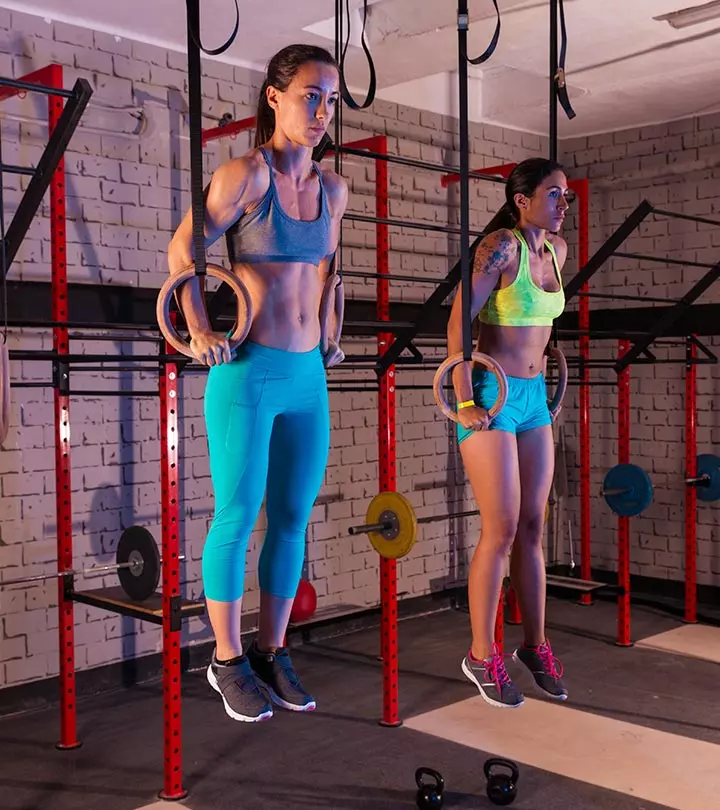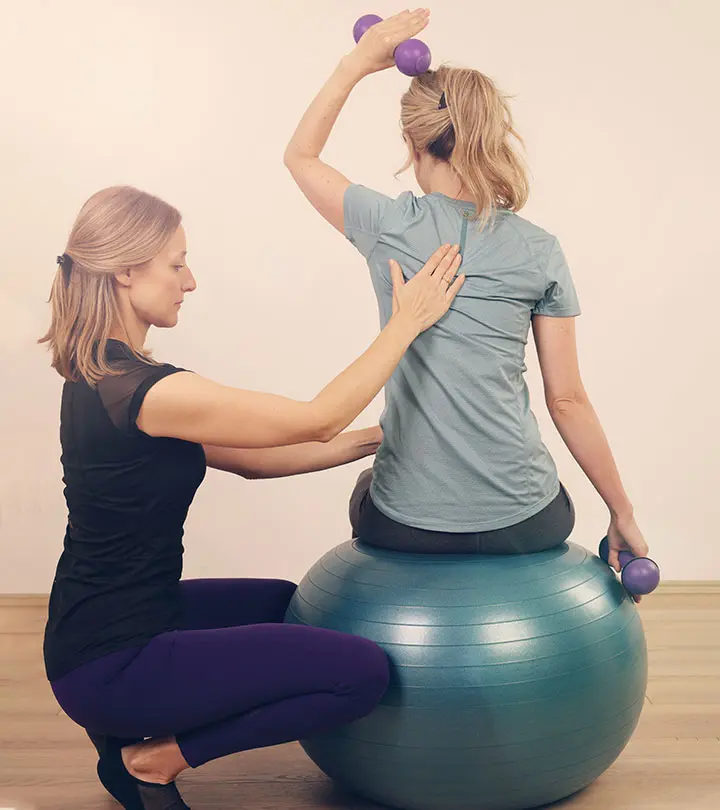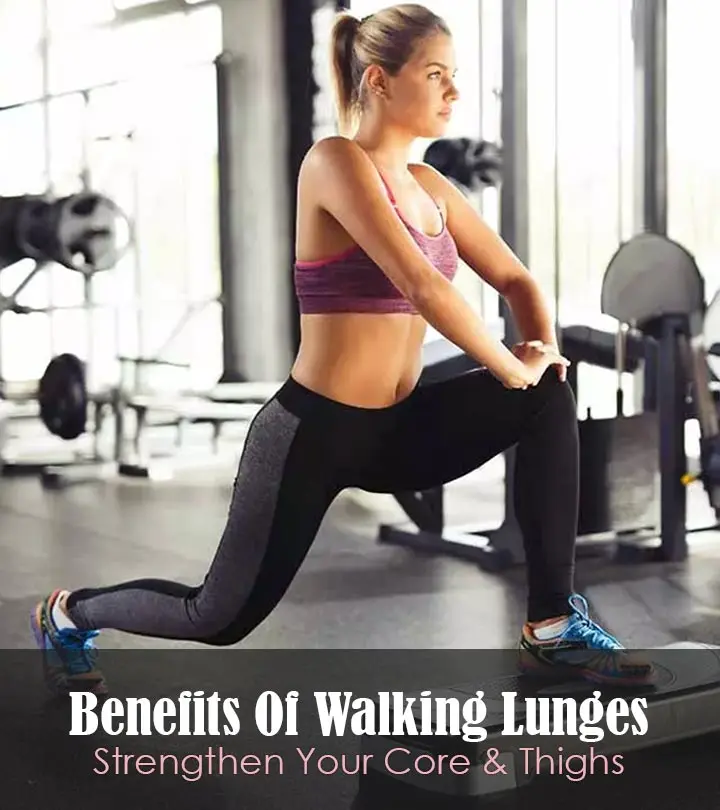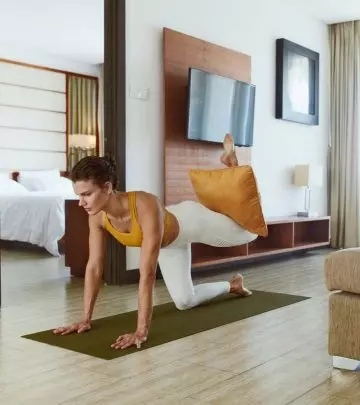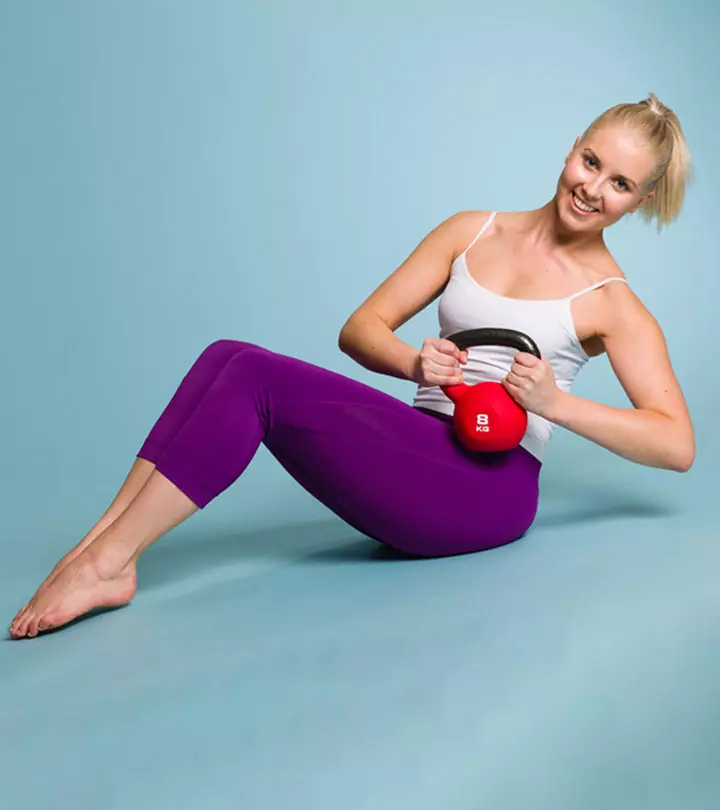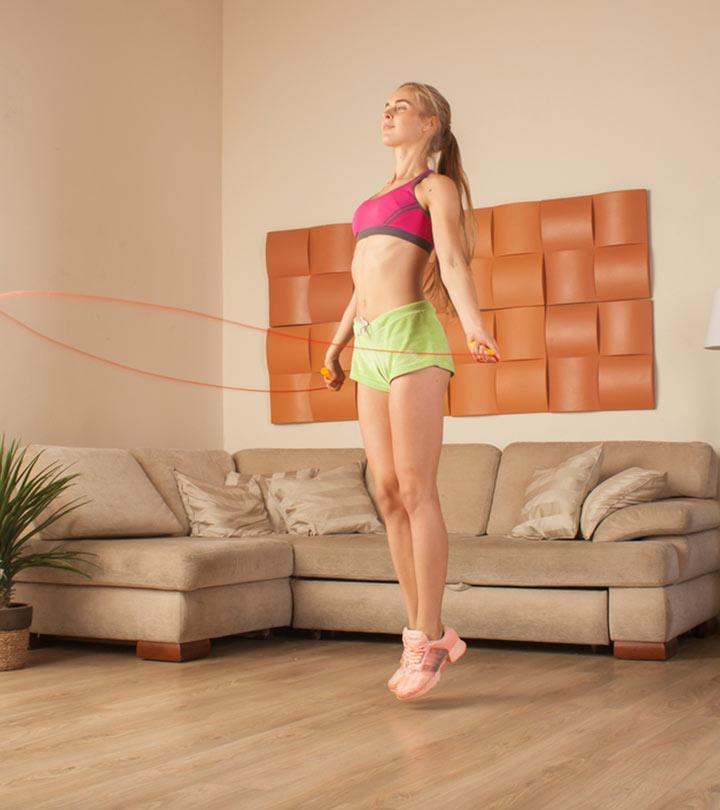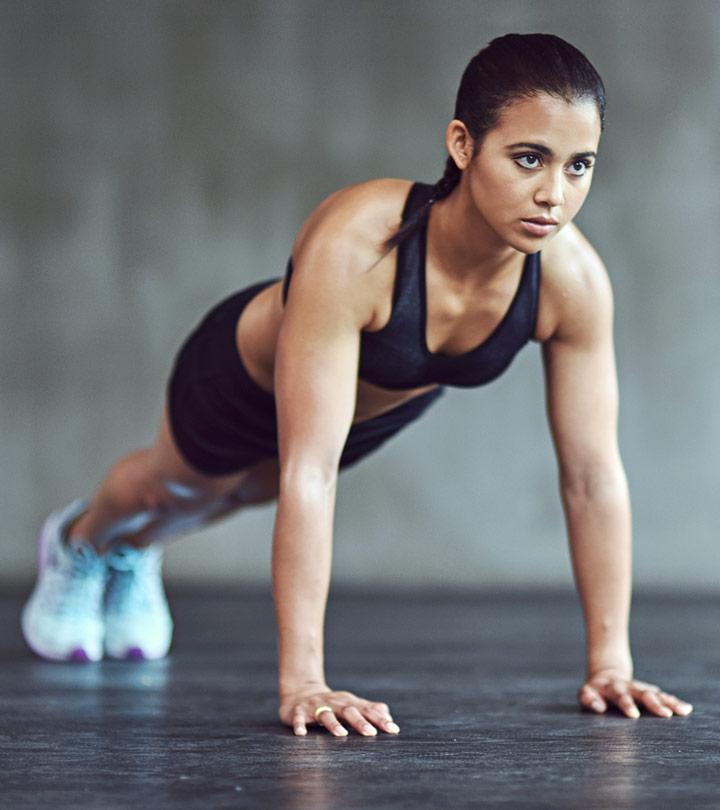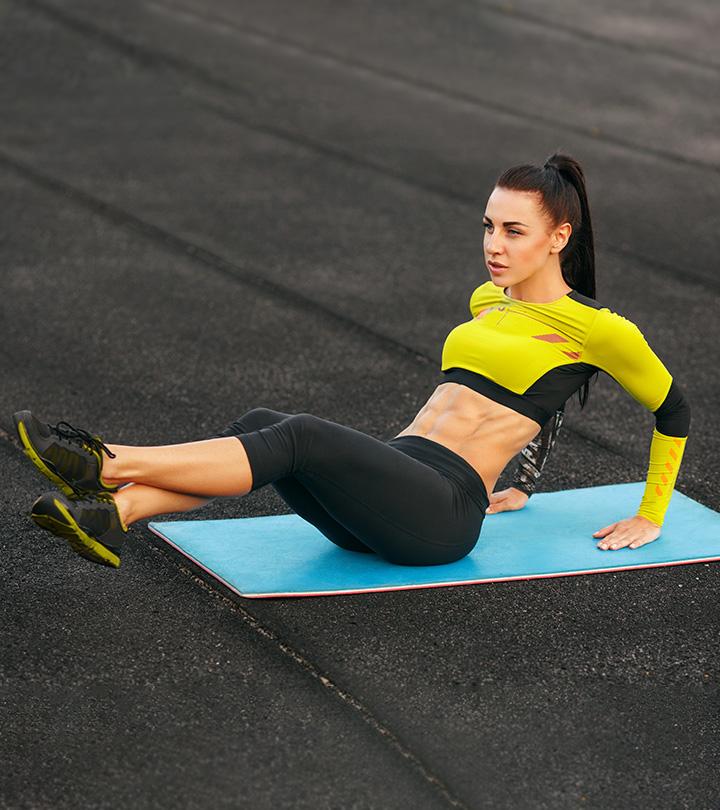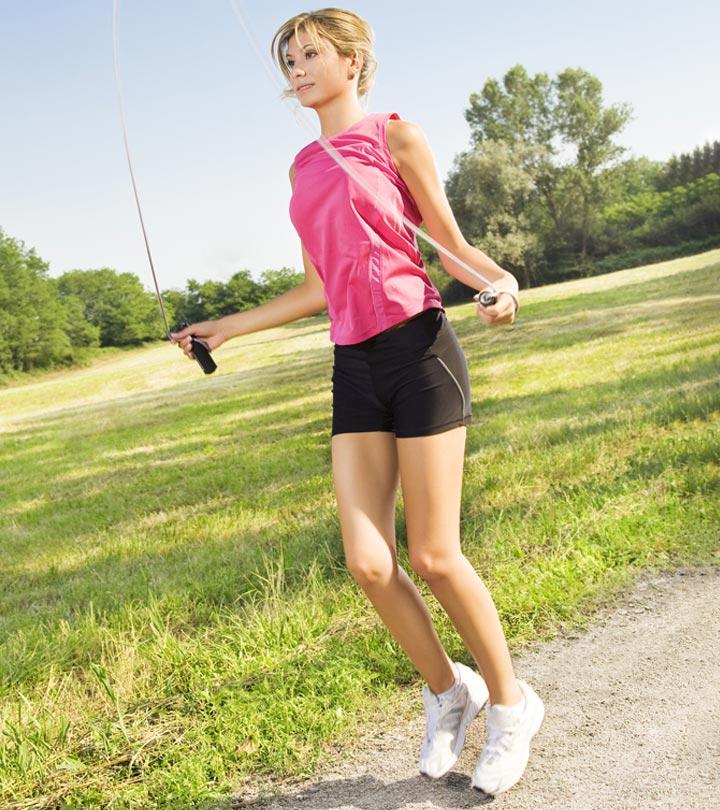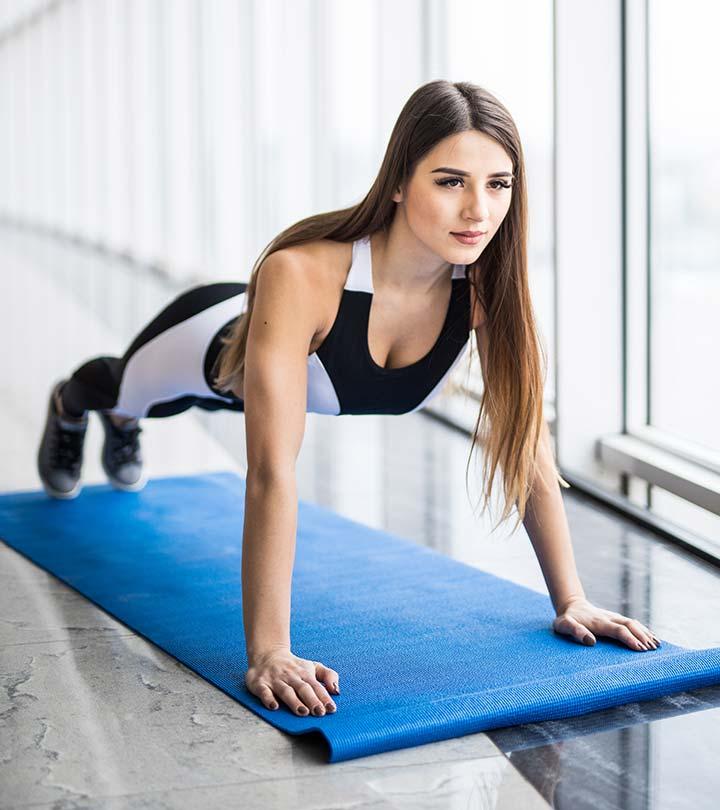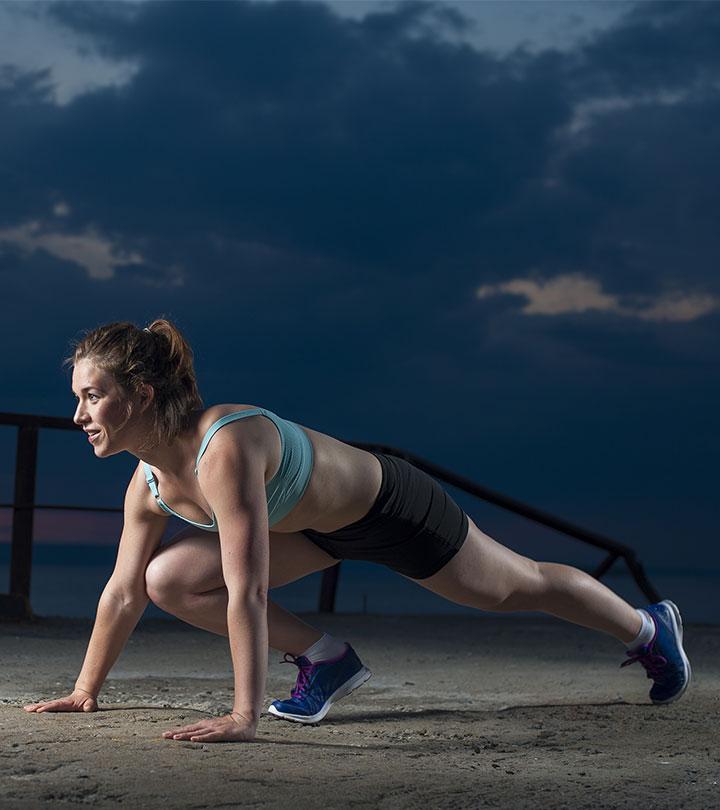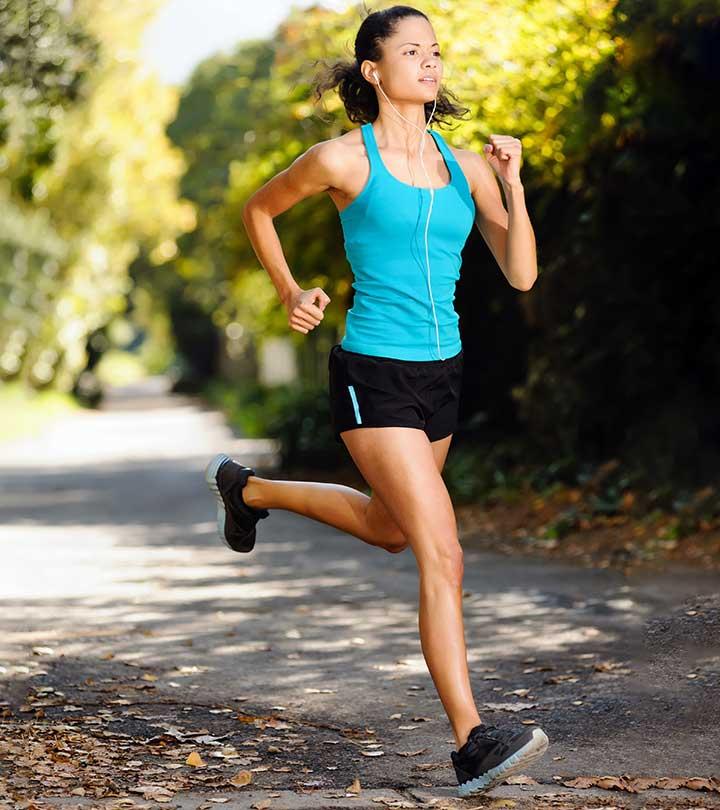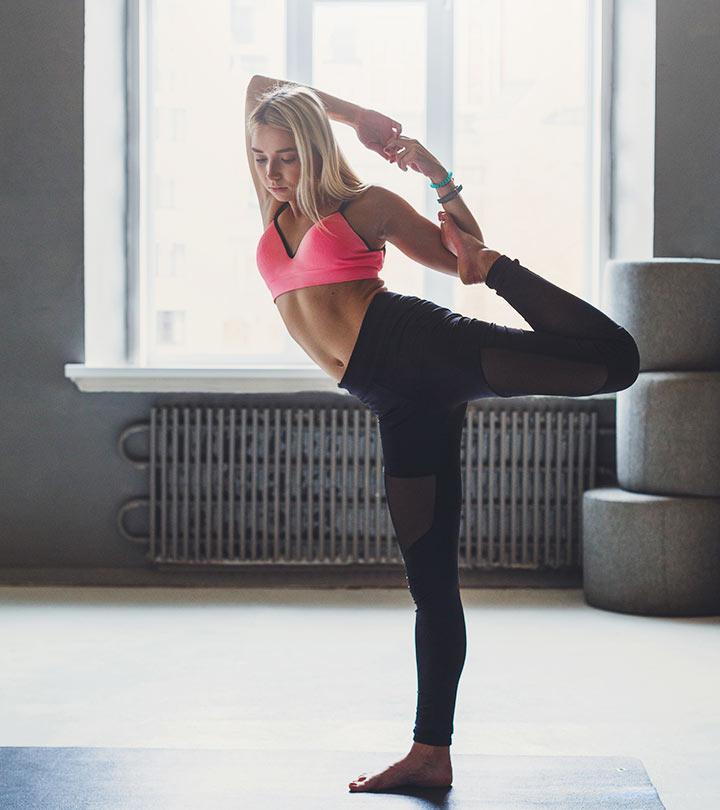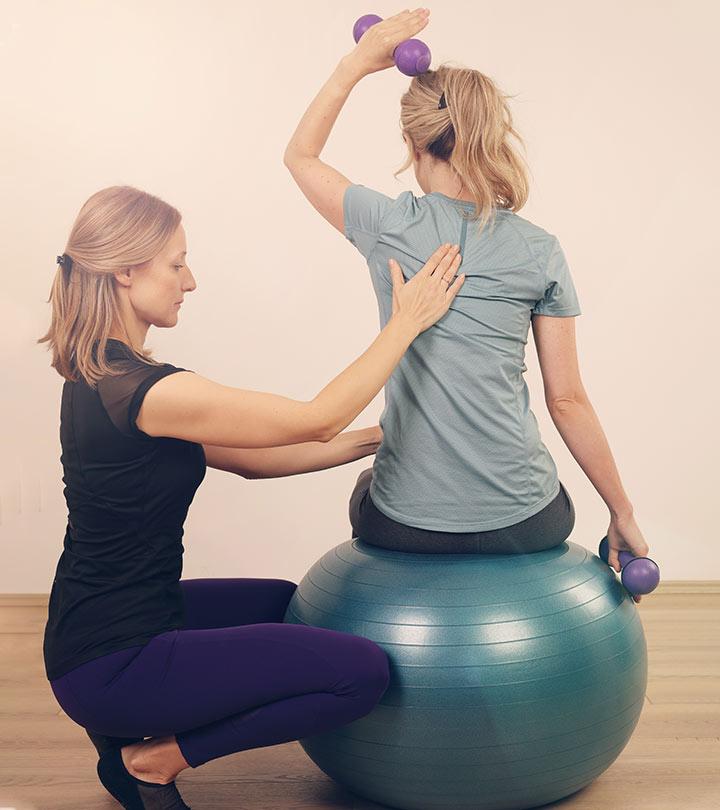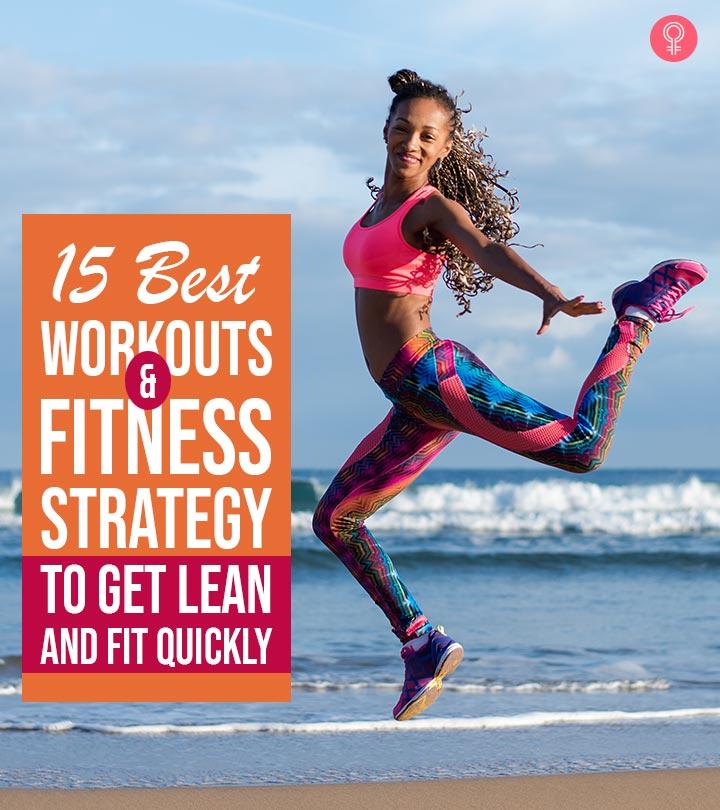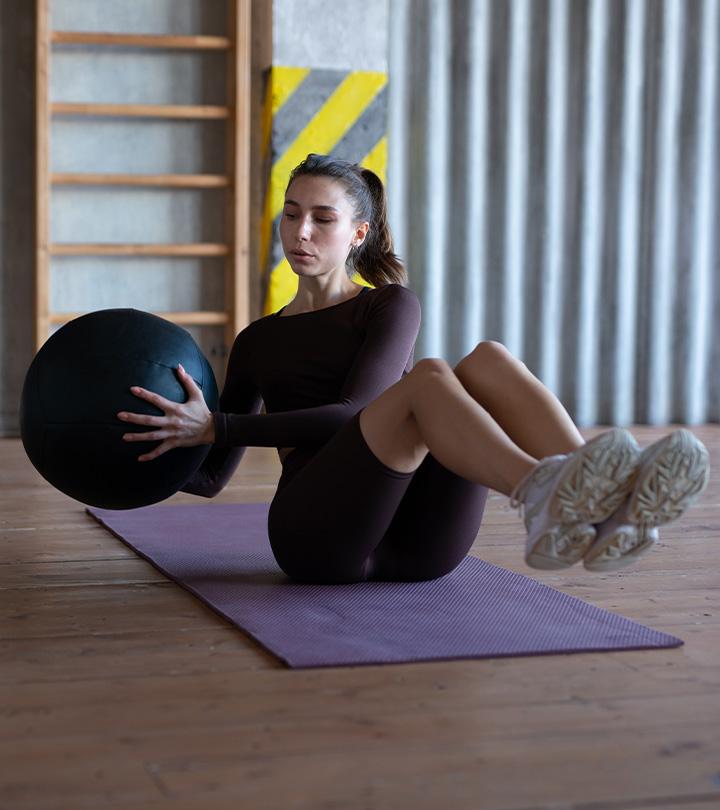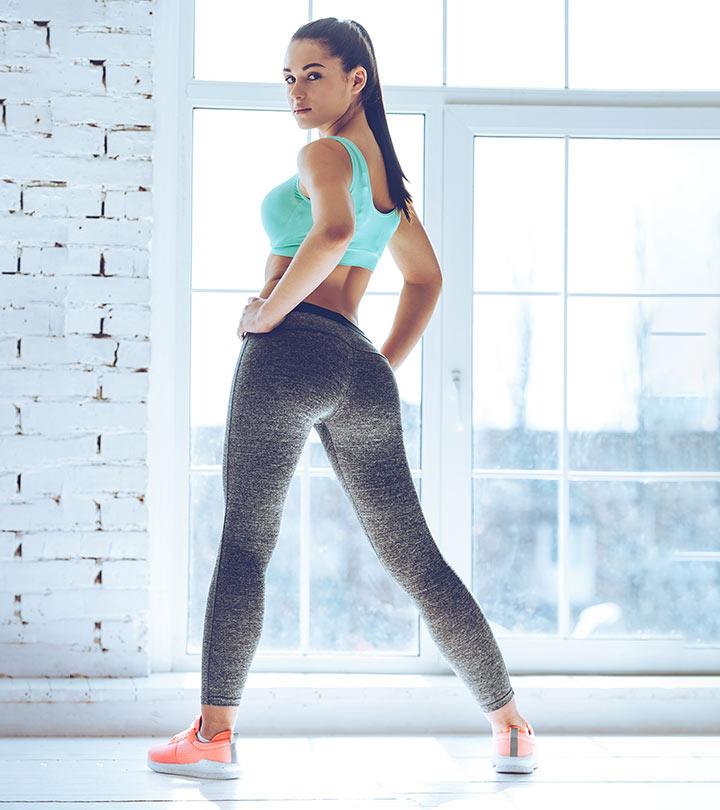11 Calisthenics Exercises For Beginners To Strengthen Muscles
Increase your agility, flexibility, and strength with these beginner and advanced exercises.
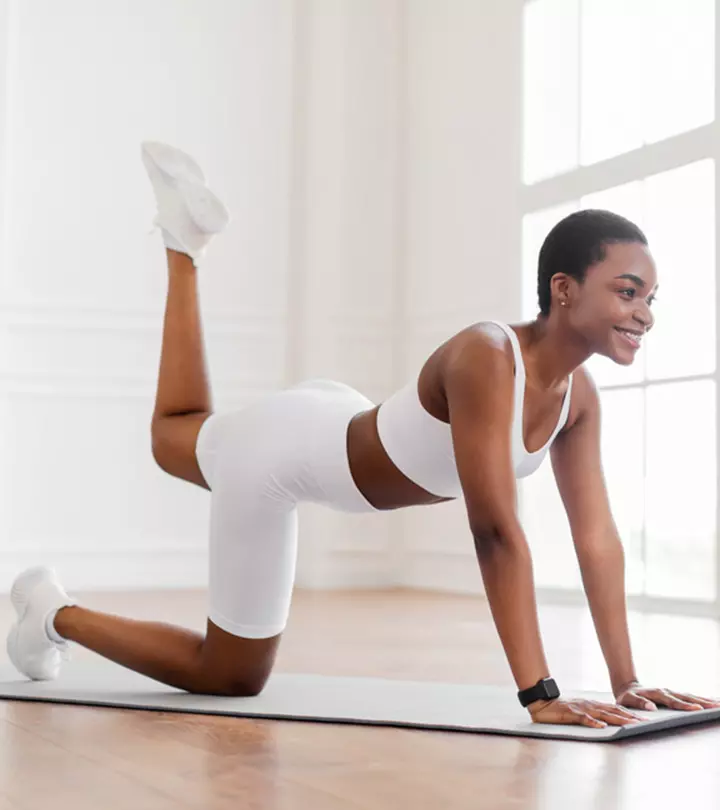
Image: Shutterstock
Calisthenics exercises are body weight-based exercises performed using different levels of intensity. This exercise form is a kind of strength training or circuit training that involves various movements performed rhythmically.
These exercises are great for beginners as they help improve coordination, enhance lower limb muscle flexibility, and boost upper-body muscle strength and endurance (1), (2), (3).
These exercises activate large muscle groups and work on every part of your body. The good news is that you need minimal equipment to perform calisthenics. This article explores the 11 top calisthenics exercises for beginners. Keep reading to know more.
 Workout Blueprint: Calisthenics Exercises For Beginners
Workout Blueprint: Calisthenics Exercises For Beginners- Frequency: Daily
- Benefits: Strengthen muscles, improve balance and coordination, and boost stamina.
- Equipment Needed: Pull up bar, box, sturdy chair, bench, exercise mat.
- Space Required: Small area
- Assistance Required: No
- Who Should Avoid: Anyone with lower back pain, hip injury, or knee issues.
In This Article
11 Effective Calisthenics Exercises For Beginners
1. Jumping Jacks
Jumping jacks are one of the most common moves for burning calories and strengthening the body. They provide good cardio and are beneficial for the heart and lungs. This workout plan is one of the foundation exercises in calisthenics.
Works On – Lats, shoulders, chest, calves, hamstrings, glutes, and core
Steps
- Stand straight with your feet together and arms at your side.
- Inhale and jump while kicking your legs out and wide.
- Raise your arms overhead simultaneously. For good measure, you can clap or join your hands.
- Again, jump and bring your hands down and your feet back together.
- Do 2 sets of 30 reps.
 Trivia
Trivia2. Prisoner Squat Jumps
Prisoner squat jumps are a modified version of squat jumps that are inspired by plyometrics. The various positioning of arms in the prisoner squats work on the core and lower body.
Works On – Glutes, quads, hamstrings, calves, lower abs, and mid abs
Steps
- Stand straight with your feet shoulder-width apart and toes pointing out.
- Put your hands behind your head with your elbows high and pointing out to the opposite side.
- Squat down low with your torso slightly forward. Keep your spine straight and knees above your heels. Do not let your knees overshoot the heels.
- Jump up as high as you can with your hands behind your head.
- Land softly and get back into the squat position.
- Do 3 sets of 5 or 8 reps.
3. Lunge Jumps
Jump lunges are great for toning and strengthening your legs and improving balance and coordination. Alternating jump lunges also help burn calories and build lower body limb strength.
Works On – Hamstrings, quads, calves, glutes, and lower abs
Steps
- Stand straight with your feet shoulder-width apart. Keep your shoulders rolled back and chest out, and look forward.
- Take your right foot forward and lunge by bending both knees until the right thigh is parallel to the floor. Make sure that the knees do not overshoot the heels.
- Jump and land softly on the floor with your left leg forward and right leg behind.
- Lunge down by bending your knees until the left thigh is parallel to the floor. This completes one repetition.
- Do 3 sets of 8 reps.
4. Bicycle Crunches
Bicycle crunches help burn fat from the abdominal area, improve coordination, and build a strong core.
Works On – Obliques, lower abs, upper abs, mid abs, quads, hamstrings, glutes, lats, and shoulders
Steps
- Lie down on a mat, bend the knees, keep your feet flat on the floor, and push your lower back to the floor.
- Place your hand behind your head with your elbows pointing out, lift your head, and look at the knees. Do not tuck in your neck.
- Lift your legs off the floor. This is the starting position.
- Extend your right leg and crunch up to touch the right elbow with the left knee.
- Bring your right leg to the initial pose. Extend your left leg and crunch up to touch your left elbow to your right knee. This completes one repetition.
- Do 3 sets of 8 reps.
5. Sit-Ups
Sit-ups target the belly region and are a great way to build core strength and endurance. The placement of the hands (behind your head or overhead) determines the muscles sit-ups work on.
Works On – Lower abs, mid abs, upper abs, hip flexors, chest, shoulders, quads, and hamstrings
Steps
- Lie down on a mat. Keep your knees bent, feet flat on the floor, and both hands extended over your head. Push your lower back down on the floor.
- Engage your core, press your heels on the floor, lift your hands off, and then your head and upper body. Come to a sitting position with the forearms touching your knees.
- Exhale and slowly lie back on the floor, keeping your hands over your head. This completes one repetition.
- Do 3 sets of 8 reps.
 Quick Tip
Quick Tip6. Wall Push-Ups
Wall push-ups help improve the chest and arm muscles. They help build upper body strength required to do regular push-ups with better ease. Once these become too easy, you can progress to incline push-ups.
Works On – Pectorals (chest), biceps, lats, and core
Steps
- Stand two steps away from a wall, facing it.
- Place your palms on the wall and keep your hands shoulder-width apart. This is the starting position.
- Bend your elbows and lean towards the wall.
- Stop when your chest is about to touch the wall.
- Exhale and push back to the starting position.
- Do 3 sets of 12 reps.
7. Incline Push-ups
The incline push-up challenges the core muscles and helps tone the arms, chest, and shoulders. It helps improve balance and upper body muscle endurance.
Works On – Pectorals, rear deltoids, biceps, and core
Steps
- Place your hands shoulder-width apart on a bench, sofa, or box. Extend your legs back and feet together.
- Keep your eyes on the bench. Do not tuck your neck in. Align your spine, buttocks, and legs in a straight line. This is the starting position.
- Engage your core and bend your elbows to lower your chest towards the bench.
- Stop when your chest almost touches the bench.
- Exhale and push your body back to the starting position.
- Do 3 sets of 8 reps.
8. Side Lunges
Side lunges target the inner thighs and lower body. They help build balance, coordination, and lower body muscle strength.
Works On – Adductors, hip flexors, glutes, hamstrings, and quads
Steps
- Stand straight with your feet shoulder-width apart, palms together, shoulders rolled back, and chest out. This is the starting position.
- Take one step to the right with your right leg, bend your right knee, and lower your body to the right. Make sure your buttocks are pushing out, and the weight is on your right leg. The right knee should not overshoot the right heel.
- Push your body backward and get to the starting position.
- Do the same on the left. This completes one repetition.
- Do 3 sets of 8 reps.
9. Donkey Kicks
Donkey kicks are best for shaping the glutes and improving the muscle tone of the lower body. They also help build core strength and upper body muscle endurance.
Works On – Glutes, hamstrings, quads, core, and shoulders
Steps
- Get down on all fours. Make sure your elbow is directly below the shoulders. Tuck your core in to engage the muscles.
- Lift your right leg off the floor. Push your right foot to the ceiling without extending the leg.
- Bring it back to the starting position and kick up again. Keep breathing.
- Do 10 kicks before changing legs and repeating the same.
- Do 2 sets of 10 reps for each leg.
10. Triceps Dips
Triceps are muscles present at the back of your upper arm. Toning this area can be a challenge. Thankfully, these dips are perfect calisthenics for the triceps and the upper body.
Works On – Triceps, shoulders, and core
Steps
- Sit on the chair or bench, whatever you are using for the dips.
- Grip the chair ends on your sides and push yourself forward off the chair such that your posture remains the same as sitting on a chair.
- This is your posture for doing the tricep dips.
- Bend your elbows and lower yourself as low as you can until your triceps become parallel to the ground.
- Push yourself to the original position.
- Do 3 sets of 12 reps.
11. Walking Lunges Exercise
Walking lunges are an excellent exercise for toning and strengthening the leg muscles. They also enhance balance and coordination and aid in calorie burning.
Works On – Quads, calves, glutes, hamstrings, and lower abs
Steps
- Stand straight with your feet at a hip-width distance.
- Roll your shoulders back, chest out, and look forward.
- Put your right leg forward and bend both knees, keeping the right leg at a 90° angle. Ensure your right knee does not go past your feet.
- Hop and land softly with your left leg forward and your right leg behind.
- Lunge down again by bending your knees until your left thigh is parallel to the floor. This counts as one repetition.
- Perform 3 sets of 8 repetitions to complete the exercise.
These are the top 11 calisthenics exercises for beginners to improve body strength and physical fitness. Once you get a grip on these, you can move on to the advanced calisthenics exercises. Check out the following section to learn 5 advanced calisthenics exercises.
5 Advanced Calisthenics Exercises
1. Burpees
Most people have a love-hate relationship with this ultimate fat-burning workout. Burpees, also called squat jump thrusts, are a cardio-strength training combination move.
Works On – Core, glutes, shoulders, chest, hamstrings, and quads
Steps
- Stand straight with your abs tight, and shoulders rolled back.
- Get down into a squat position and put your hands on the floor in front of your feet.
- Balancing your weight on your hands, jump and thrust your body back into a plank position.
- Jump back to the previous position and stand up.
- Do 3 sets of 8 reps.
- To intensify this move, do a push-up after getting into the plank position.
2. Box Jump
Ready to take squats to the next level? Do box jumps. This calisthenics exercise helps improve balance and coordination, burn a lot of calories, and are great for a lower body workout.
Works On – Glutes, hamstrings, quads, and lower abs
Steps
- Place a sturdy box about 1-2 steps away from you.
- Stand straight with your feet shoulder-width apart.
- Bend down slightly and propel your body into a jump. Keep your eyes on the box.
- Land softly on top of the box. Keep your body slightly bent forward to prevent falling back on the floor. Squat down.
- Get up and jump back on the floor. This completes one repetition.
- Do 3 sets of 8 reps.
3. Push-Up
Push-ups are great for building chest, shoulder, and core strength and endurance. If you don’t find the regular push-up challenging, try one-arm push-ups.
Works On – Pectorals, deltoids, biceps, triceps, and core
Steps
- Get into a high plank position. Keep your elbows right below the shoulders, core engaged, and look at the top of the mat. Do not tuck your neck in or look upwards.
- Keeping your legs, spine, and head in the same line, bend your elbows and slowly lower your chest to the floor.
- Stop right when your chest is about to touch the floor.
- Push your body back up to the high plank position. This completes one repetition.
- Do 3 sets of 8 reps.
4. Chin-Ups
Chin-ups are a great way to build upper body strength and endurance. They also serve as a prepping exercise for pull-ups. All you need is a bar secured at a height to perform this exercise.
Works On – Pectorals, deltoids, biceps, triceps, and lats
Steps
- Stand right below the bar. Jump up and grip the bar with both hands and palms facing you. Your hands should be shoulder-width apart. Bend your knees and cross your legs. This is the starting position.
- Curl your biceps and pull your body up. Stop when your chin is just above the bar.
- Slowly extend your hands and go back to the starting position. Exhale. This completes one repetition.
- Do 3 sets of 8 reps.
5. Pull-Ups
In pull-ups, you increase upper body strength by working all the muscles from your limbs to your core. It is perfect for burning calories and muscle toning.
Works On – Pectorals, deltoids, lats, biceps, triceps, and core
Steps
- Hold a sturdy, secured pull-up bar at a height. Position your hands slightly wider than shoulder-width apart and palms facing outward. Bend your knees and cross your legs. This is the starting position.
- Engage your core and bend your elbows. Pull your body up until your chin is above the bar.
- Slowly return to the starting position by extending your hands and lowering your body. This completes one repetition.
- Do 3 sets of 8 reps.
Why should you do calisthenics? What are the benefits? Let’s dig deep in the following section.
Benefits Of Calisthenics Exercises
- Help in building and strengthening muscles.
- Improve balance, agility, and coordination.
- Enhance stamina, strength, and flexibility.
- Prevent muscle and joint injuries caused by heavy weight lifting.
- Can be performed anywhere by all age groups.
- Improve your control over your body.
- Burn calories.
- Help in building lean muscles instead of the bulky look added by weights.
- Suitable for beginners.
Dr.Mehmet Yildiz, a scientist, shared the benefits of him doing calisthenics in his blog. He said, “When I noticed flexibility improvement in my muscles and gaining agility, growth, and strength, I fell in love with it (i).”
Calisthenics (or bodyweight training) are a great way to stay fit and look and feel good. But if you are curious why you should opt for bodyweight exercises and not simply jump to weight training, scroll down to the next section.
Calisthenics Vs. Weight Training
Calisthenics and gymnastics use your body weight for exercise training, while weight training and functional fitness training include the use of dumbbells, barbells, resistance bands, or other equipment. In calisthenics, the resistance is provided by the weight of the body. This helps the muscles work in coordination with other muscles to improve fitness, strength, balance, and coordination.
Weight training might specifically be used to build muscles and tone up. On the other hand, calisthenics can be used to burn calories, shed fat, and improve muscle tone.
Weight training and calisthenics can both be directed to focus on only a particular body part, such as the glutes, core, or upper body. While it is possible to combine high-intensity cardio along with bodyweight training, it is impractical and unsafe to train with 20-pound dumbbells with high-intensity cardio.
Calisthenics also have their limitations. Here’s what you need to know.
Know This Before You Start Calisthenics
- Calisthenics are difficult. You need to have a basic level of fitness in terms of muscle strength and endurance to complete the sets and reps.
- Calisthenics will not help you build muscles or bulk up. They will only help tone your muscles and improve power, stamina, and endurance.
- Performing calisthenics faster without taking care of the form can lead to injuries.
- Measuring progress is tough.
Infographic: Calisthenic Exercises
Calisthenic exercises are known for improving strength and endurance. In addition, these exercises improve coordination and flexibility.
Check out the following infographic to learn about the:
- Benefits of calisthenic exercises
- Ways to incorporate calisthenic exercises into your fitness routine
- Tips to increase the effectiveness of these exercises
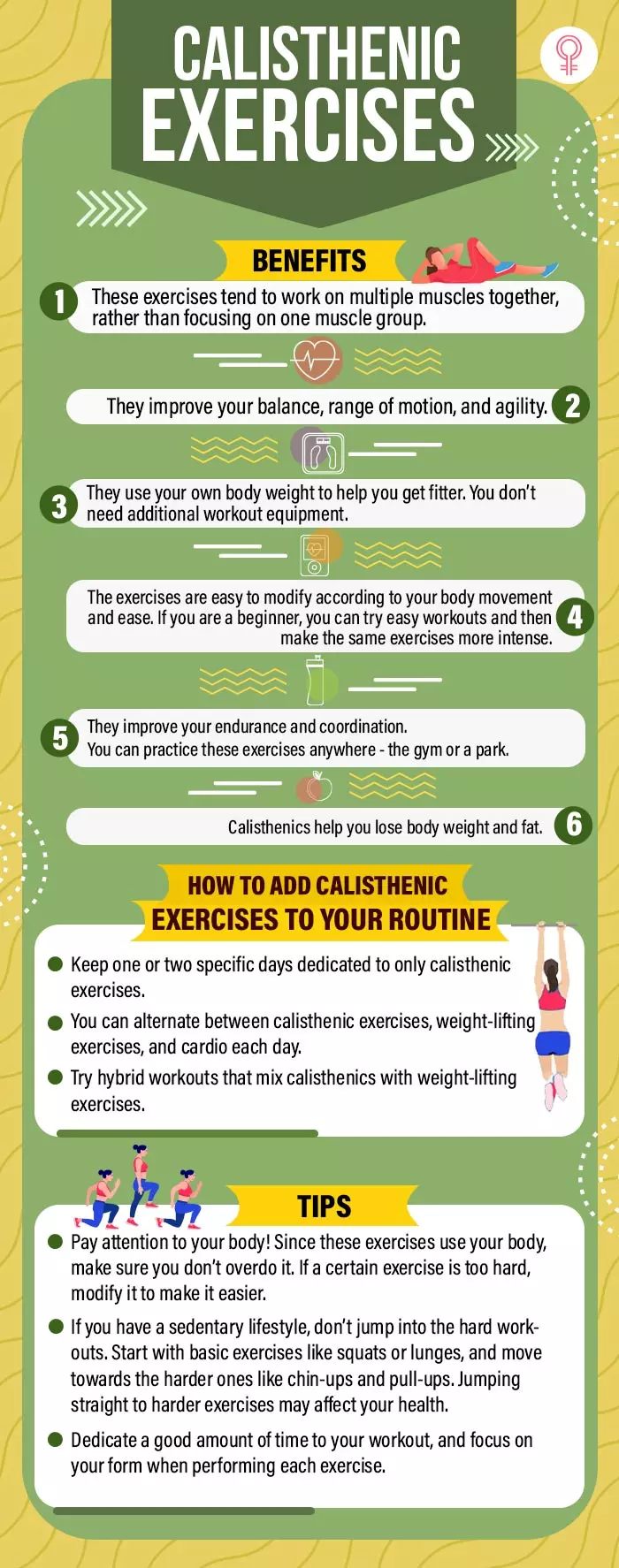
Illustration: StyleCraze Design Team
Calisthenics exercises can be done anywhere, in the comfort of your home or at the gym. You can get started right away with a mat and some comfortable clothes. Calisthenics improves your endurance, agility, and range of motion. Progress gradually by starting with the beginner exercise module and then moving on to the complex advanced ones. You can boost your muscle tone and overall fitness in just a matter of weeks with these exercises. Make sure that you are doing the exercises correctly, as incorrect form can lead to injuries or muscle pains.
Frequently Asked Questions
Is it okay to do calisthenics every day?
Yes, daily calisthenics bring benefits to your health and fitness levels. But do listen to your body to ensure safety. Build strength and improve your overall health by performing calisthenics regularly.
Is calisthenics better than bodybuilding exercises?
Whether to choose calisthenics or bodybuilding depends on your fitness goals. Both offer unique benefits. You may also consider combining them for a well-rounded fitness plan.
Should you do cardio with calisthenics?
Yes, you can enhance your calisthenics routine by adding cardio exercises. This dynamic combination will boost your cardiovascular health, support your weight loss journey, and help you build strength. Take your fitness to new heights with this effective and enjoyable workout combination
Key Takeaways
- Jumping jacks, prisoner jump squats, bicycle crunches, lunge jumps, wall pushups, and sit ups are some excellent calisthenics exercises for beginners.
- Advanced calisthenics exercises include burpees, push ups, pull ups, and box jumps.
- The resistance provided by the weight of the body in calisthenics helps to improve fitness, strength, balance, and coordination.
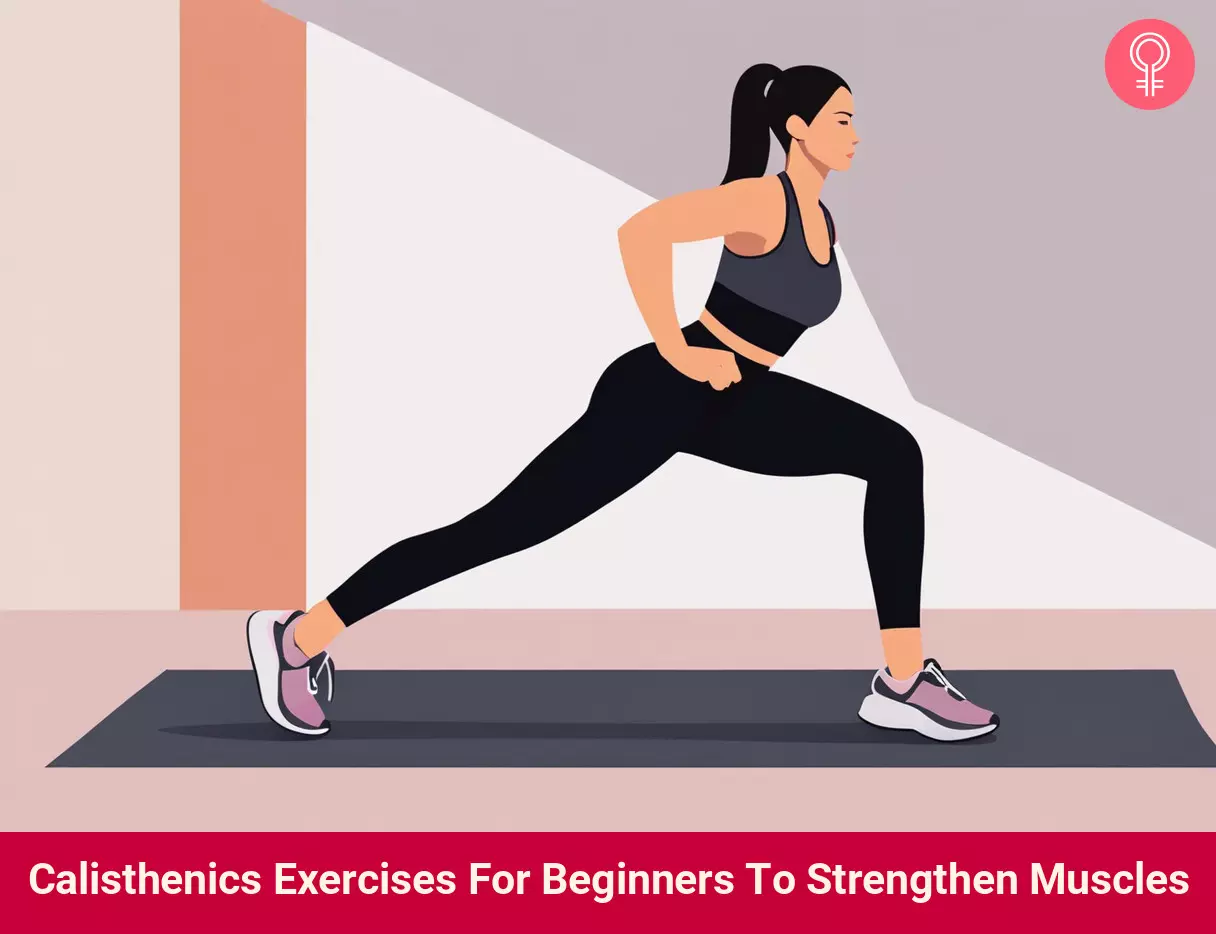
Image: Stable Diffusion/StyleCraze Design Team
Start your calisthenics journey with these 11 exercises. Watch this video to learn the beginner workout routine and get fit in no time.
Personal Experience: Source
StyleCraze's articles are interwoven with authentic personal narratives that provide depth and resonance to our content. Below are the sources of the personal accounts referenced in this article.
(i) Here’s What Happened When I Performed Calisthenics for Decadeshttps://medium.com/sensible-biohacking-transhumanism/calisthenics-shaped-my-body-and-lifted-my-mood-for-decades-7aa9426b6571
References
Articles on StyleCraze are backed by verified information from peer-reviewed and academic research papers, reputed organizations, research institutions, and medical associations to ensure accuracy and relevance. Read our editorial policy to learn more.
- Effects of calisthenics and Pilates exercises on coordination and proprioception in adult women: a randomized controlled trial
https://pubmed.ncbi.nlm.nih.gov/22104298/ - Effects of bodyweight-based exercise training on muscle functions of leg multi-joint movement in elderly individuals
https://pubmed.ncbi.nlm.nih.gov/19702936/ - Effect of Progressive Calisthenic Push-up Training on Muscle Strength and Thickness
https://pubmed.ncbi.nlm.nih.gov/29466268/
Read full bio of David Rosales
Read full bio of Arshiya Syeda
Read full bio of Himanshi Mahajan






